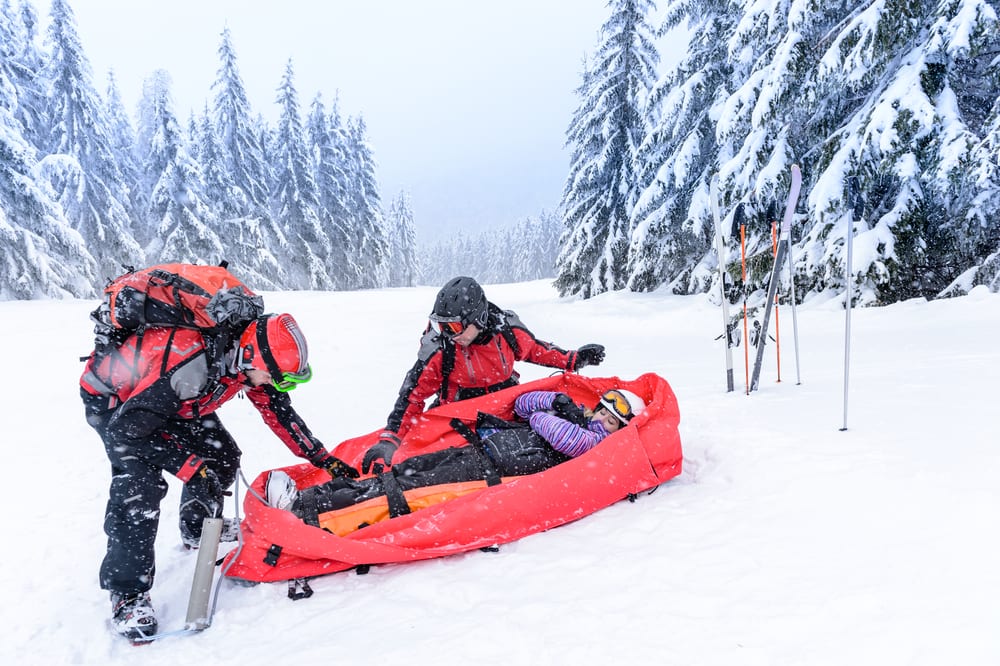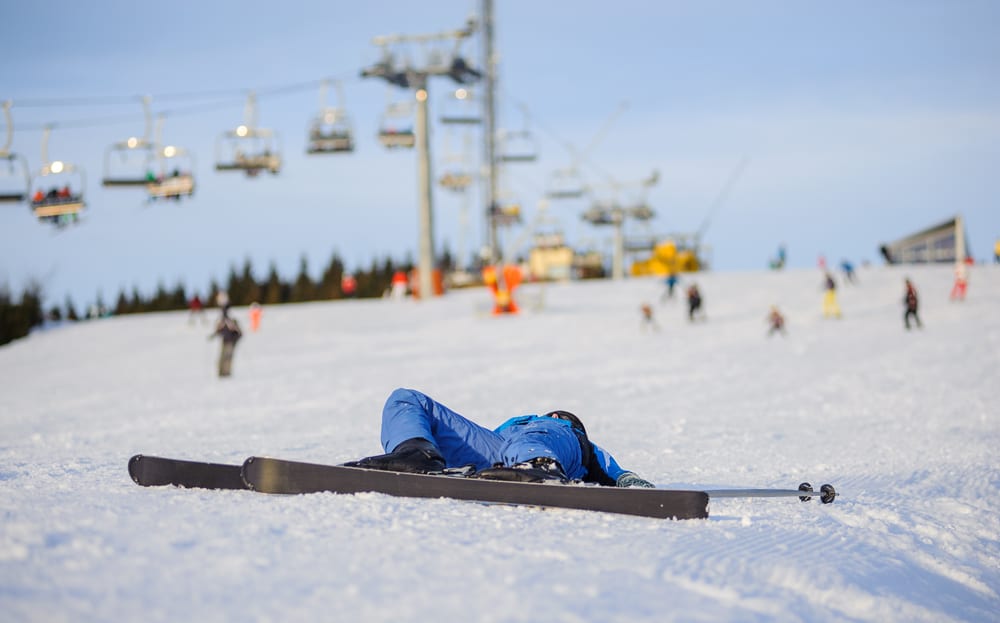As the powder froth hits for another winter we can expect to see the steady flow of injured skiers being stretchered off the resort slopes and hear stories of people rescued from the backcountry.
Skiing is an inherently risky activity and accidents are always going to happen, knowing what to do when you or a mate get into a jam on the slopes can mean the difference, in some cases, between life and death.
Be prepared with our list of tips and live to ski/board another day.
Accidents within the ski resort
The worst skiing injuries will usually happen inside the resort boundaries simply due to people’s confidence levels being much higher due to a range of factors. You can ski way faster on nicely groomed slopes, there are terrain parks with massive jumps outside people’s skill levels and there are simply more people skiing of very mixed abilities that you have no control over.
We also have the safety net of professional and volunteer ski patrollers roaming the slopes on the lookout for people to scrape off the snow if something does go wrong.
But just following a few golden rules will help minimise the risk of an accident happening in the first place.
Be familiar with the Alpine Responsibility Code that you’ve legally agreed to follow when you buy a lift ticket. The key aspects of the responsibility code worth keeping in mind at all times include skiing in control, giving way to people below you (they can’t see behind them) and don’t stop below rollovers. If you do have to pull up to wait then do so on the side of a run (not in the middle) and in full view for those above you.
Oh, and Wear a helmet if you like having a brain. (click for more)
There are more ways to reduce your risk of injury. Try not to ski alone on-piste and definitely not alone off-piste. You could be 20 metres from a groomed run and not be found until spring if you get knocked unconscious.
If you ski with a backpack, get in the habit of carrying a spare puffer jacket and emergency blanket to keep someone warm if they’ve been injured.
Use your mobile phone to save your life
Ski with a well-charged mobile phone in a warm pocket (use hand warmers in your pockets to save battery life) and save your resort’s ski patrol phone number on it.
These Australia resort patrol numbers are current as of July 2022 – Thredbo (02) 6459 4147 Perisher (02) 6459 4666 Mt Hotham (03) 5759 4038 Falls Creek (03) 5758 3502 Mt Buller (03) 5777 7808.
If you’re ever in doubt about who to call in an emergency, call 000 (zero, zero, zero) in Australia (or 111 in New Zealand) and they’ll coordinate with ski patrol.

Ski with some identification in your pocket and save your own information into your phone’s medical info screen in case you’re found unconscious by someone else.
For kids skiing without adults, it’s worth giving them a mobile phone and putting a card with your contact info in their pocket if they get lost or injured. Know where you are at all times so you can tell ski patrol where to find you. e.g. “My friend’s hurt their leg below Merrits chair near Tower 7”.
When an accident happens
If an accident does happen you should do the following things.
Assess the safety of where the accident’s happened and vertically cross your skis in the snow above the victim so no-one skis into you from above. This is especially important if the victim’s below a rollover or jump others might come flying over without seeing the landing. Asking someone to stand above these areas is also very effective.
Assess the victim’s injuries by asking them “Where does it hurt?”. Don’t start prodding them to do your own amateur analysis, as this will just cause unnecessary discomfort. If you don’t know the victim find out their name and how to contact their companions.
Call ski patrol or 000 as soon as you’ve assessed the situation. Tell them where you are, what the possible injury is and the victim’s name if you know it. They’ll usually get to you within 10 minutes on a normal run.
If there’s no phone reception, stay with the victim and ask someone else to ski to the bottom of the lift to alert ski patrol, providing the same information about where you are and what’s happened. You should stay with the victim under all circumstances unless you’ve handed that responsibility over to someone else.
If the victim’s able to move, get them comfortable and warm with any extra puffer jackets or space blanket you might be carrying. Put these over their existing clothing so you’re not trying to remove things they’re already wearing. Most victims will go into shock, so they need warmth and reassurance that help’s on the way.
Don’t remove boots or helmets, as these might be providing support to injuries or just keeping the victim warm.
If the victim’s unconscious, check their breathing and roll them into the recovery position on their side to ensure they don’t choke on their tongue. If you’re unsure about moving them due to spinal injuries and can closely monitor their breathing, just leave them in the position you found them.
If they’re definitely not breathing and you’ve been trained in First Aid, commence CPR or call out for help from a passer by that might be more confident in doing this. This is a critical life threatening situation, so it’s more important to get them breathing again than to worry about spinal injuries in moving them.
Throughout this type of scenario, it’s critical you remain calm and reassuring for the victim. If you can’t do this yourself, find a passerby that can take the lead. Anyone trained in First Aid should be more than happy to practice their skills.
Accidents in the backcountry
Remember that “sidecountry” is still “backcountry” for all intents and purposes. You might be able to see the resort, but you’re still essentially on your own if something goes wrong.
You need members of your group to be trained in First Aid and be carrying a well-stocked First Aid Kit amongst other safety equipment. It’s complete foolhardiness not to have these skills or equipment in the backcountry.
If you have mobile reception, call 000 in Australia (111 in New Zealand and 911 in USA and 911 or 112 in Canada), as the Police will lead any search and rescue operation.
Be sure to make it clear to the emergency operator that you’re in a wilderness location and that you have latitude and longitude GPS coordinates to give them. You can get this off your phone’s compass app or on a standalone GPS and just make sure you confirm the operator has received the coordinates correctly. Back this up with information about any landmarks you’re near.
If you don’t have phone reception, activate your Personal Locator Beacon that you definitely need to carry if you’re in the backcountry. These can be bought for under $300 online or borrowed from National Parks offices and will send your location to emergency services via satellite if activated.
If the victim can’t move under their own effort, there’s absolutely no point trying to carry them out if you’ve been able to call or signal for help. You won’t be charged money for a rescue in Australia or New Zealand, so just sit tight and wait for help to arrive.
Under no circumstances should the victim be left alone or less than two people leave to get help. You don’t want one accident to lead to multiple casualties.
Keep the victim warm, as a rescue might be hours away and hypothermia is probably the worst risk they now face if they’re conscious. This will mean getting them off the snow and putting whatever you have on hand underneath them – backpacks, spare jackets, space blankets and such.
Stabilise any injuries as best you can in the interest of keeping the victim comfortable, such as splinting legs or slinging arms as per your First Aid course instruction.
Above all, don’t panic! You need to remain calm and confident for the victim and help will eventually get to you if you’ve taken adequate safety equipment with you.
Just reading a post like this is a first step in being more confident about what to do if an emergency does happen, so feel free to add your own tips in the comments section below.







